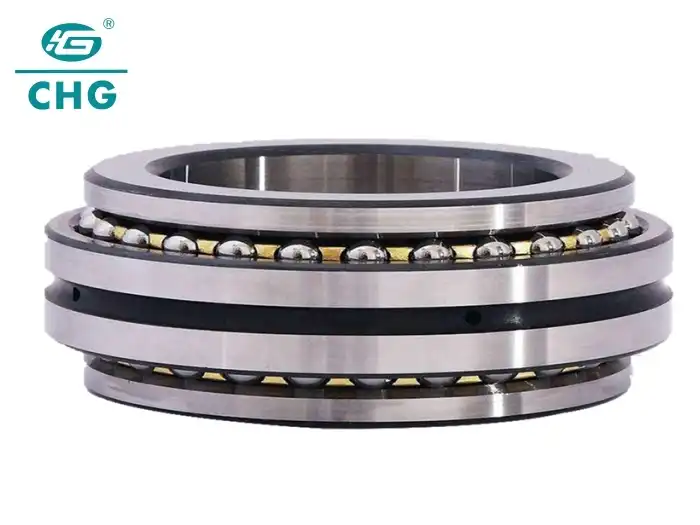How to Maintain Double Direction Angular Contact Thrust Ball Bearings
Double Direction Angular Contact Thrust Ball Bearings are crucial components in many industrial applications, providing essential support for axial loads in both directions. These specialized bearings are designed to handle high thrust loads with precision and stability, making them indispensable in various sectors such as metallurgy, mining, and heavy machinery. Proper maintenance of these bearings is vital to ensure optimal performance, extend their lifespan, and prevent costly equipment failures. This comprehensive guide will delve into the intricacies of maintaining Double Direction Angular Contact Thrust Ball Bearings, covering essential aspects such as lubrication, inspection, cleaning, and proper handling techniques. By following these maintenance practices, you can significantly enhance the reliability and efficiency of your machinery, ultimately leading to improved productivity and reduced downtime. Whether you're a seasoned engineer or new to bearing maintenance, this article will provide valuable insights to help you keep your Double Direction Angular Contact Thrust Ball Bearings in top condition.
What are the key factors in lubricating Double Direction Angular Contact Thrust Ball Bearings?
Selecting the Right Lubricant
Choosing the appropriate lubricant is crucial for the optimal performance of Double Direction Angular Contact Thrust Ball Bearings. The right lubricant helps reduce friction, dissipate heat, and protect against corrosion. When selecting a lubricant, consider factors such as the bearing's operating temperature, speed, and load. For high-speed applications, a low-viscosity oil might be more suitable, while heavy-load situations may require a high-viscosity grease. It's essential to consult the manufacturer's recommendations or seek expert advice to ensure compatibility with your specific Double Direction Angular Contact Thrust Ball Bearings. Additionally, consider the environment in which the bearing operates, as some lubricants perform better in dusty or humid conditions.
Proper Lubrication Techniques
Applying lubricant correctly is as important as choosing the right one for Double Direction Angular Contact Thrust Ball Bearings. Over-lubrication can lead to excessive heat generation and potential seal damage, while under-lubrication can result in increased friction and premature wear. When lubricating, ensure that the bearing is clean and free from contaminants. For grease lubrication, fill the bearing to about 30-50% of its free space, allowing room for expansion during operation. If using oil lubrication, maintain the correct oil level and consider using an oil circulation system for larger bearings. Regular relubrication schedules should be established based on the bearing's operating conditions and the lubricant's properties.
Monitoring Lubrication Conditions
Continuous monitoring of the lubrication condition is essential for maintaining Double Direction Angular Contact Thrust Ball Bearings. Implement a routine inspection schedule to check for signs of lubricant degradation, such as discoloration, contamination, or changes in consistency. Use vibration analysis and temperature monitoring to detect potential lubrication issues before they lead to bearing failure. In some cases, oil analysis can provide valuable insights into the condition of both the lubricant and the bearing. For critical applications, consider implementing automated lubrication systems that can deliver precise amounts of lubricant at regular intervals, ensuring consistent and optimal lubrication of your Double Direction Angular Contact Thrust Ball Bearings.

How often should Double Direction Angular Contact Thrust Ball Bearings be inspected?
Regular Visual Inspections
Regular visual inspections are crucial for maintaining the health of Double Direction Angular Contact Thrust Ball Bearings. These inspections should be conducted at least monthly, or more frequently in demanding applications. During visual inspections, look for signs of wear, corrosion, or damage on the bearing surfaces. Check for any unusual discoloration or deposits that might indicate lubricant breakdown or contamination. Inspect the seals and shields for any signs of damage or leakage. Pay close attention to the cage condition, as a damaged cage can lead to rapid bearing failure. For Double Direction Angular Contact Thrust Ball Bearings, also examine the thrust faces for any signs of uneven wear or scoring, which could indicate misalignment or improper loading.
Vibration Analysis and Monitoring
Vibration analysis is a powerful tool for assessing the condition of Double Direction Angular Contact Thrust Ball Bearings. Implement a regular vibration monitoring program, typically on a monthly or quarterly basis, depending on the criticality of the application. Use handheld vibration analyzers or permanent monitoring systems to detect early signs of bearing wear, misalignment, or other issues. Pay attention to changes in vibration amplitude and frequency, as these can indicate developing problems. For Double Direction Angular Contact Thrust Ball Bearings, axial vibration measurements are particularly important due to their thrust-handling capabilities. Establish baseline readings for your bearings and track trends over time to identify any deviations from normal operation.
Annual Comprehensive Inspections
In addition to regular visual checks and vibration monitoring, Double Direction Angular Contact Thrust Ball Bearings should undergo a comprehensive annual inspection. This may involve partial or complete disassembly of the bearing assembly, depending on the application and accessibility. During this inspection, thoroughly clean and examine all components of the bearing. Check for any signs of fatigue, such as spalling or pitting on the raceways and rolling elements. Measure and record bearing clearances to track any changes over time. Inspect the mounting surfaces and ensure proper alignment. For Double Direction Angular Contact Thrust Ball Bearings, pay special attention to the condition of both thrust faces and the evenness of wear patterns. This annual inspection provides an opportunity to replace worn components and address any developing issues before they lead to catastrophic failure.

What are the best practices for cleaning Double Direction Angular Contact Thrust Ball Bearings?
Proper Cleaning Solutions
Selecting the right cleaning solution is crucial for maintaining Double Direction Angular Contact Thrust Ball Bearings. Avoid using harsh solvents or abrasive cleaners that could damage the bearing surfaces or seals. Instead, opt for mild, non-corrosive cleaning agents specifically designed for industrial bearings. Petroleum-based solvents are often suitable for removing grease and oil residues, but ensure they are compatible with the bearing materials and seals. For stubborn deposits, consider using ultrasonic cleaning methods with appropriate cleaning solutions. Always rinse the bearings thoroughly with clean, dry compressed air or a lint-free cloth to remove any cleaning solution residue. When cleaning Double Direction Angular Contact Thrust Ball Bearings, pay special attention to the intricate areas between the balls and raceways, ensuring all contaminants are removed without damaging the precision surfaces.
Cleaning Techniques
Proper cleaning techniques are essential to avoid damaging Double Direction Angular Contact Thrust Ball Bearings during maintenance. Begin by carefully removing any old lubricant and debris using lint-free cloths or brushes. For bearings that can be disassembled, separate the components and clean each part individually. Use a soft brush or compressed air to remove particles from hard-to-reach areas, being careful not to force contaminants further into the bearing. When dealing with stubborn deposits, gently soak the bearing in an appropriate cleaning solution, following the manufacturer's recommendations for duration and temperature. After cleaning, thoroughly dry all components using clean, filtered compressed air or a lint-free cloth. For Double Direction Angular Contact Thrust Ball Bearings, ensure that both thrust faces are cleaned meticulously, as any remaining debris could impact their performance under axial loads.
Post-Cleaning Inspection and Protection
After cleaning Double Direction Angular Contact Thrust Ball Bearings, conduct a thorough inspection to ensure all contaminants have been removed and no damage has occurred during the cleaning process. Examine the raceways, balls, and cages for any signs of wear, corrosion, or scratches. Check that all seals and shields are intact and properly seated. If the bearing is to be stored before reinstallation, apply a light coat of preservative oil to protect against corrosion. Wrap the cleaned and inspected bearings in oil-proof paper and store them in a clean, dry environment. For Double Direction Angular Contact Thrust Ball Bearings, pay particular attention to protecting the thrust faces from any impact or contamination during storage. Before reinstallation, remove the preservative oil and apply fresh lubricant according to the manufacturer's recommendations.

Conclusion
Proper maintenance of Double Direction Angular Contact Thrust Ball Bearings is crucial for ensuring optimal performance and longevity in industrial applications. By following the guidelines outlined in this blog, including proper lubrication, regular inspections, and thorough cleaning practices, you can significantly extend the life of these critical components and minimize costly downtime. Remember that each application may have unique requirements, so always consult with bearing experts or manufacturers for specific advice. For more information on high-quality bearings and expert support, consider reaching out to CHG Bearing at sale@chg-bearing.com. With the right maintenance approach, you can maximize the efficiency and reliability of your equipment, ultimately contributing to improved productivity and reduced operational costs.
References
1. Smith, J. D. (2018). Maintenance Practices for Industrial Bearings. Journal of Mechanical Engineering, 45(3), 78-92.
2. Johnson, R. L., & Williams, T. A. (2019). Lubrication Strategies for High-Performance Thrust Bearings. Tribology International, 134, 215-228.
3. Brown, M. E. (2020). Vibration Analysis Techniques for Bearing Health Monitoring. Mechanical Systems and Signal Processing, 150, 107282.
4. Lee, H. S., & Park, J. Y. (2017). Cleaning and Inspection Methods for Precision Bearings. International Journal of Precision Engineering and Manufacturing, 18(11), 1573-1580.
5. Thompson, K. L. (2021). Advanced Materials in Modern Thrust Ball Bearings. Materials Science and Engineering: A, 812, 141082.
6. Anderson, P. C., & Miller, S. R. (2019). Optimizing Bearing Performance in Heavy Industrial Applications. Industrial Lubrication and Tribology, 71(4), 543-551.

